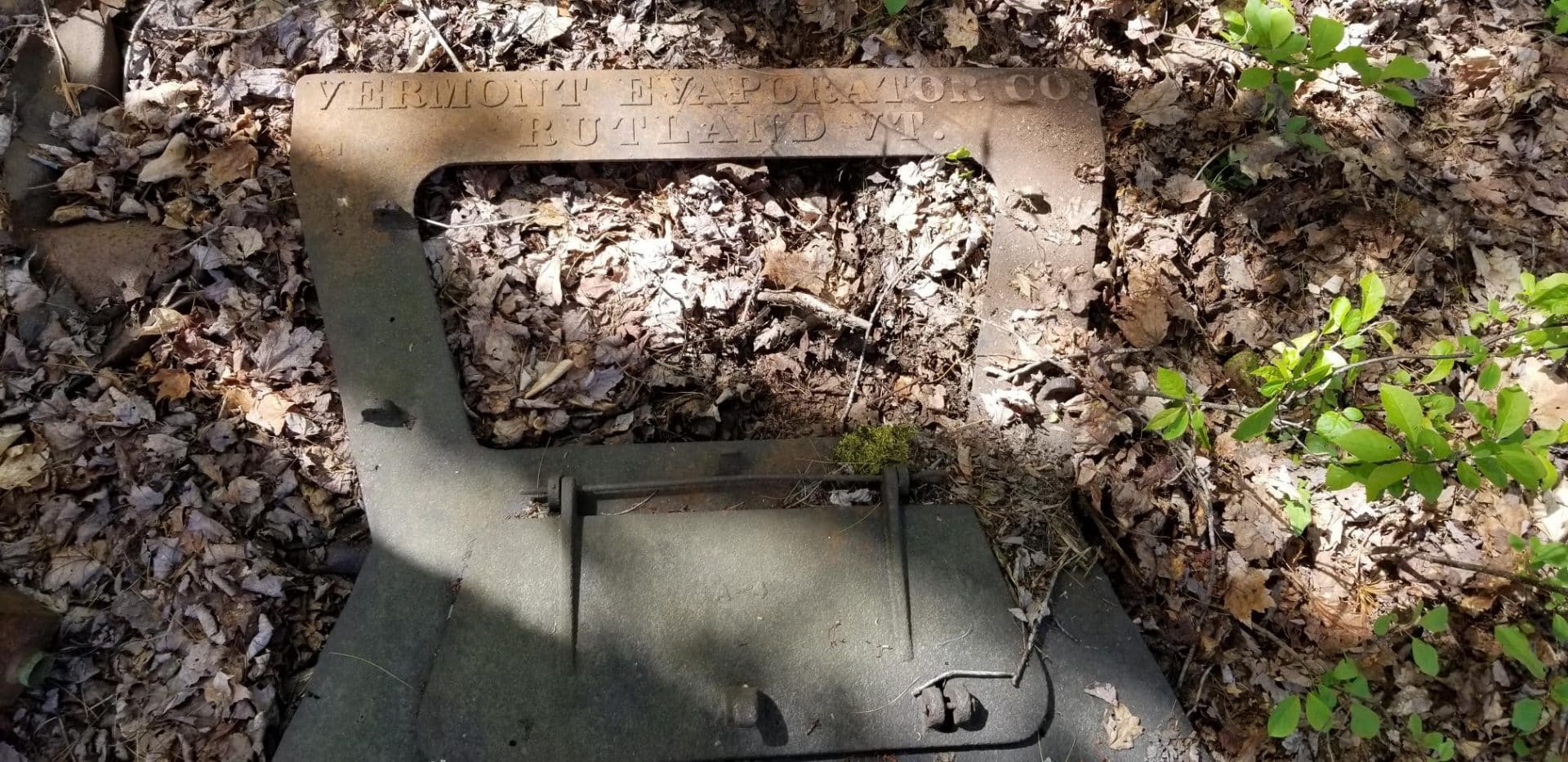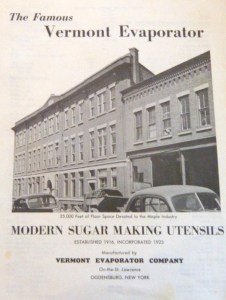This antique evaporator door was made by a Vermont Evaporator Company that operated a century ago. A customer of this Vermont Evaporator Company found it in his sugar woods last spring!
Have you encuntered the remains of a long-lost sugar camp or evaporator in your sugar woods and wondered what its story was? Maple Historian Matthew M. Thomas does too. Here’s what we’ve learned from him about the OTHER Vermont Evaporator Company and more!
In 1916, three friends—Robert, Gus and Thomas—started the Vermont Evaporator Company. The friends started out in a 2,380 square foot, one-story building in North Clarendon, Vermont, intending to manufacture and sell a full line of maple syrup making tools and equipment for the professional sugar maker.
Almost exactly 100 years later, a married couple named Kate and Justin started the Vermont Evaporator Company in half of a 2,500 square foot granite shed in Montpelier, Vermont, intending to make and sell backyard evaporators for the hobbiest.
Besides the slight differences in customer base and a full century—the invention of the automobile, two world wars, a moon landing, the civil rights movement, the invention of the internet, and the end of the millenium—these stories are poetically similar. When a customer of this Vermont Evaporator Company found the remains of an evaporator built by that Vermont Evaporator Company in his sugar woods this spring, we decided to learn more.
The cover of this Vermont Evaporator Company Catalog touts fame and modernity.
It didn’t take long for us to rediscover Matthew M. Thomas, author of “Maple King; The Making of a Maple Syrup Empire” and “A Sugarbush Like None Other; Adirondak Maple Syrup and the Horse Shoe Forestry Company.” Thomas’s scholarship in the industrial history of maple sugar and maple syrup production is dizzying. We were delighted to discover that he had published this piece on the first Vermont Evaporator Company already and thankful for his permission to pass along what we learned from him to you!
If that Vermont Evaporator Company and this Vermont Evaporator Company started out in a similar manner, that soon changed. By the time the first Vermont Evaporator Company was two years old, it was already in significant legal trouble, and undergoing both a relocation to Rutland, Vermont and an expansion by virtue of a $50,000 investment. (Today, that would be nearly three-quarters of a million dollars.) Even with all that dough, by the time the company was 4 years old, it had filed for voluntary bankruptcy. At 5 years of age, the company got in trouble with state tax authorities, and before it celebrated its 7th birthday, its factory burned to the ground.
(In contrast, we’d like to think we’re slow and steady; small but mighty. While our financial beginnings were considerably more modest, we’ve had comparatively smooth sailing, pandemic-be-darned, and just celebrated our sixth birthday last week without legal trouble, bankruptcy or fires and with expansion into a new 5,000 square foot facility!)
Ironically, things got better for the first Vermont Evaporator Company after they moved to New York. Despite another fire early on, the company found success both in expanding their sales region for maple syrup equipment and buying syrup in bulk and repackaging it for consumer markets. In fact, the company would go on operating until 1972, when the city of Ogdensburg, New York forced a sale of the company’s factory using the power of eminent domain for an urban renewal project. A few months before demolition of the building, Vermont Evaporator Company was sold to Leader Evaporator Company.
This Vermont Evaporator Company calalog cover promises “rapid, practical, shallow boiling” with its “maple utensils.”
While Leader Evaporator Company no longer makes the old Vermont Evaporator Company products like it did shortly after the acquisition, it is still a major player in the maple syrup equipment and supply industry.
And while we can’t claim to be much of a fish in that ocean, this Vermont Evaporator Company is sizeable in our own pond, at least for now!
What artifacts have you found in your sugar woods? Has your interest in maple history been piqued? Would you like to learn more? Here are some suggestions for further reading:
Thomas’s maple blog, hosted at www.maplehistory.com, really is the best place to start, no matter what kind of maple syrup history strikes your fancy. You will be amazed at what you can learn there. Posts are organized by geography and topic and range from the history of the elimination of lead in maple syrup in Quebec to Anishinabe land use rights to the early history of the plastic maple jug, and beyond.
Thomas reviews many maple history books on his blog as well, and we can recommend two books by Thomas himself.
We reviewed “Maple King; The Making of a Maple Syrup Empire” in a previous blog post. Maple King is a fascinating and well-written book about George C. Cary, a personality that looms as large in the world of maple as Rockefeller does in oil, Carnegie in steel, and the Great Gatsby did in your high school English class.
“A Sugarbush Like None Other; Adirondak Maple Syrup and the Horse Shoe Forestry Company,” is an equally interesting archeological reconstruction of the Horse Shoe Forestry Company, a totally unique Adirondak area maple operation from the gilded age. This book is not for the faint-of-reading, though! Less novelistic and more textbooky than Maple King, a genuine interest in archeology is a mandatory prerequeisite for enjoying this read. If that’s intimidating, start with the pictures! You may just get hooked.



